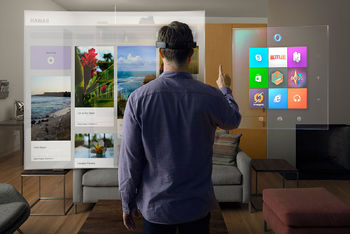Windows Mixed Reality
| Windows Mixed Reality | |
|---|---|

| |
| Information | |
| Type | Augmented Reality |
| Subtype | Optical head-mounted display |
| Developer | Microsoft |
| Operating System | Windows 10 |
| Devices | Microsoft HoloLens, Windows Mixed Reality Headsets |
| Website | https://www.microsoft.com/microsoft-hololens/en-us |
Introduction
Windows Mixed Reality, formerly Windows Holographic, is a Augmented Reality and Virtual Reality Software Platform incorporated in Windows 10 operating system. It utilizes Microsoft HoloLens, an OHMD, to project Windows 10 apps and other high-definition digital imageries or holograms onto real life objects. Holographic allows users to interact with these virtual objects through gaze, gestures and voice commands.
Announced on January 21, 2015, Windows Mixed Reality was introduced with the release of Windows 10 along with Microsoft HoloLens.
On June 1, 2016 in Computex, Microsoft announced that they are opening Windows Mixed Reality to third party developers. They have partnered with HTC, Acer, Asus, Lenovo and HP.
On August 28, 2017, Microsoft announced that they have partnered with Valve to have games and experiences from Steam to run on Windows Mixed Reality Headsets.
Contents
Features
- All Windows universal apps can become holograms. Holograms can be 2D (a TV or another screen) or 3D (a real object).
- Users can interact with holograms. Gaze, gesture and voice are supported input methods.
- The OHMD is mobile, untethered to your PC or another device.
- Computer vision is utilize to understand the device's environment.
Hardware
Integrated Headsets
Windows 10 VR Headsets
- See also: Windows 10 VR
Acer Windows Mixed Reality Headset
HP Windows Mixed Reality Headset
Apps
Windows 10 Apps - HoloLens Apps
Developer
Windows Mixed Reality API is incorporated in all devices running Windows 10, even tablets and smartphones.
HoloLens UI/UX are designed around gaze input, gesture input and voice input or GGV. World coordinates, spatial sound and spatial mapping are environmental understanding features that provide the ability for holograms to interact with both the user and the world around them.